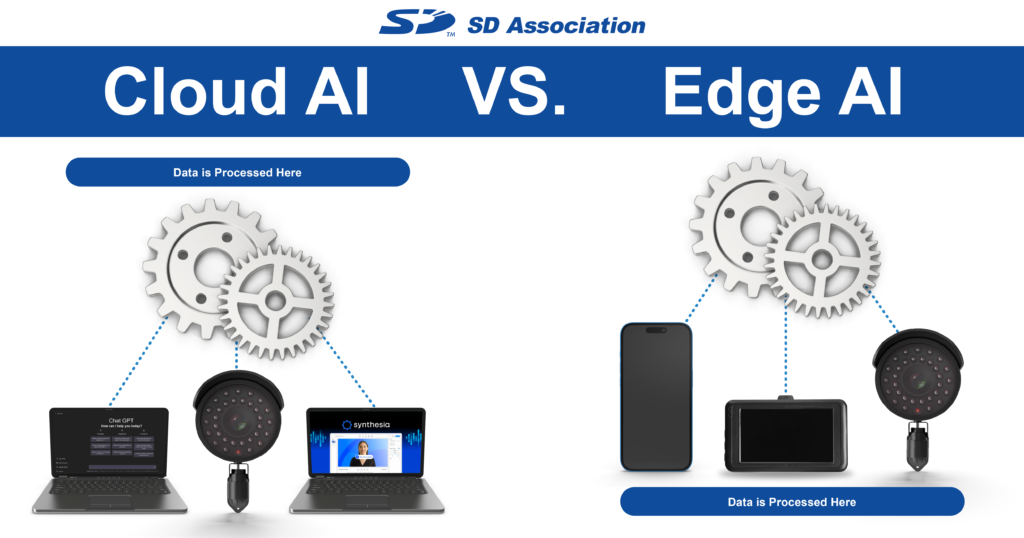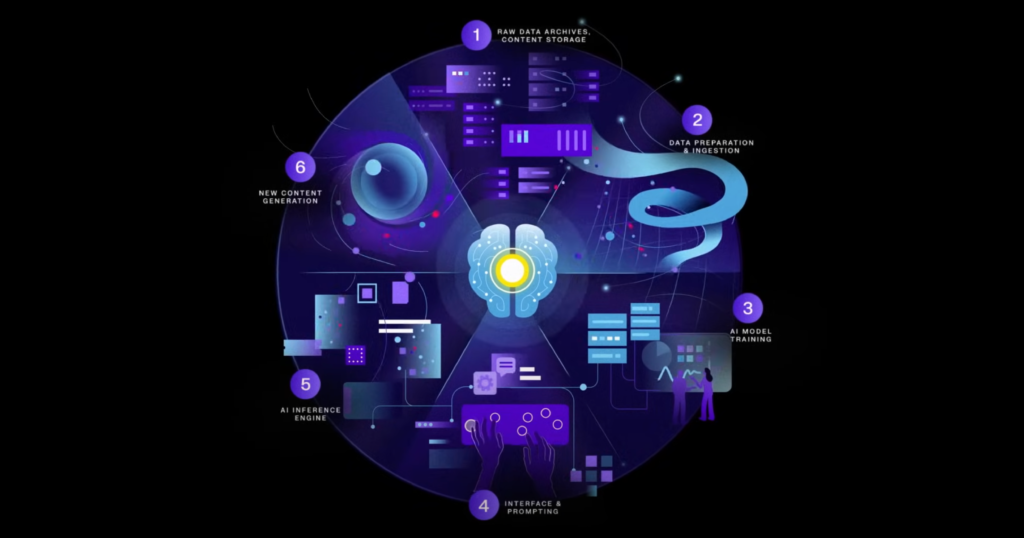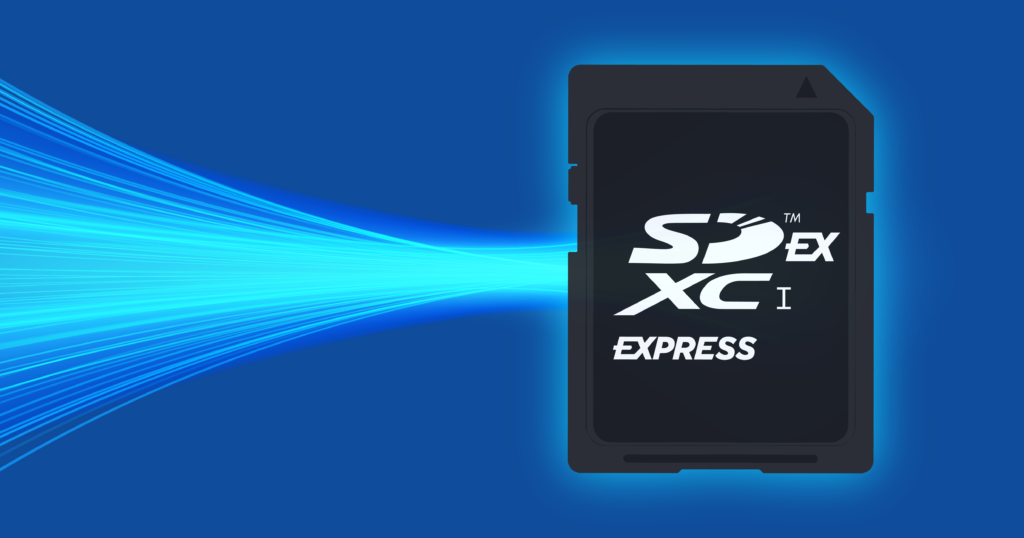The world of technology continues to rapidly evolve—a concept that is not foreign to us but remains entirely thrilling with the future of possibilities. The use of artificial intelligence (AI) applications in mobile devices, wearable technology, IoT and edge computing devices continues to rise, creating exciting opportunities for innovation.
From improving the energy efficiency of AI applications in smartphones to enhancing the performance of autonomous systems in vehicles, SD Express is prepared to strengthen the backbone of these developments.
Edge AI Versus Cloud AI: An Introduction to AI in Mobile Devices
Understanding the distinctions between Edge AI and Cloud AI is important in determining the roles and how they can work together to best fulfill our needs. Cloud AI processes data within centralized servers outside of a device, enabling complex AI models and larger computational resources. Edge AI processes data directly on the device where it’s collected, such as smartphones, dash cameras, surveillance cameras and more. Its low latency capabilities enable real-time decisions and use. Depending on individual needs, the most beneficial use of these two AI technologies is a hybrid approach.

Within the AI Data Cycle, the “Interface and Prompting” stage often utilizes edge computing for cloud and edge applications alike. For cloud-based AI, this stage can involve processing data at the network edge for faster initial responses before sending it to the cloud for more analysis. Local AI engines at the network edge, with their proximity and high-speed storage (like embedded memory, SSD, or SD Express cards), can provide faster response times.

Source: 1 Concept of the operations in AI workflows – WDC IMAGE
AI in New Mobile Technologies
The increasing adoption of AI has evolved into a widespread expectation and demand for its presence in our everyday activities, particularly as people lead increasingly mobile lifestyles. The integration of AI into mobile phones and other on-the-go devices will play an important role in enhancing the overall user experience.
Virtual assistants such as Google Assistant and real-time language translation have evolved significantly, incorporating advanced AI technologies to enhance their functionalities. These tools now utilize AI to understand context, generate responses, and interact more intuitively with users, showcasing a leap from their earlier versions which primarily focused on simple search tasks.

Android has significantly enhanced its phones with AI, introducing features like Circle to Search for homework help, Gemini for improved screen context understanding, and Gemini Nano for multimodal interactions and scam detection alerts.
Additionally, with Apple also embedding AI into its devices, it’s evident that the evolution of AI technology will consistently require strong ongoing support.
As new applications of AI emerge in glasses, headsets, and even surveillance and dash cameras, the demand for increased memory and ever faster speed is also increasing. SD Express is a solution specifically designed to address these challenges by tackling Edge AI’s key limitations. With faster processing and support of high-capacity storage, SD Express’s high-performance capabilities make it a valuable tool in the ever-evolving tech landscape.
SD Express: Meeting the Demands of Tomorrow’s AI Devices, Today
Boosted by the NVMe™ and PCIe® interface’s superior speed and performance, SD Express easily handles the massive amounts of data generated by devices and systems such as IoT sensor networks, as well as high-resolution, content-rich and speed-demanding video applications.
SD Express’s ability to move even the largest data sets quickly enables AI algorithms to process information and enhance overall technology performance. Moreover, the expansive storage capacity can hold all the data generated by AI, which is a vital capability for devices to require local data processing.
The local processing of data means that sensitive information is more secure and less likely to be exposed to external threats. Nevertheless, local processing demands powerful local security to protect against unauthorized access and breaches.

SD Specification 9 addresses these concerns with updated security features—including encryption protocols for content protection, secure boot processes, and secured host-card authentication for a card’s bundling to specific applications.
Opportunities are also unlocked with SD Express, with applications such as real-time analytics in autonomous vehicles, advanced medical imaging, and AI-powered industrial automation becoming possible and highly efficient.
The Future of SD Express and Edge AI

The true power of SD Express lies not just in its speed, but in the versatility it provides. Imagine a world where, with SD Express, a dash-cam could not only capture footage in high-definition, but also simultaneously run AI algorithms to detect pedestrians, traffic signs, license numbers of adjacent cars, or even gestures from other drivers. The footage and the AI models could be updated in real time, offering a real-time and sustainable learning environment conducive to safer, smarter mobility.
This convergence doesn’t just benefit on-road safety; it extends to new and exciting avenues for commercial and security applications, such as real-time inventory monitoring, or face and people’s behavior recognition using AI-powered surveillance and security systems. The intersection of these technologies also illuminates the path for new frontiers in healthcare, where SD Express could hold the key to personalized health solutions integrated into everyday personal devices.
As a leading technology that can meet and even extend the demands of dynamic AI, SD Express can help support and reimagine the technological future of various industries. Manufacturers and engineers should use it to its full potential—explore new technologies, develop new devices, and take the next step in the age of innovation. Learn how to easily add SD Express to your products using off-the-shelf solutions, today by watching our video.




